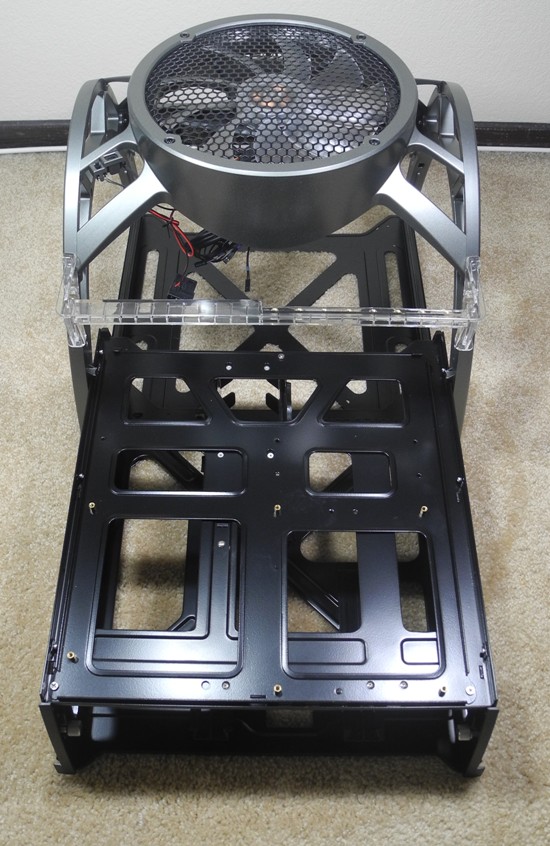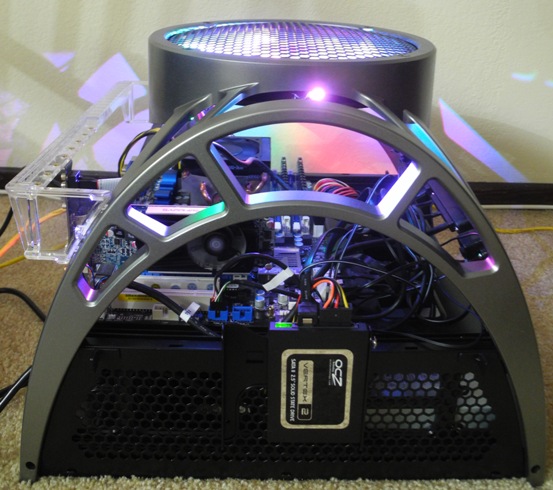AMD A8-3850 : An HTPC Perspective
by Ganesh T S on June 30, 2011 6:20 AM EST
AMD provided us with an A8-3850 CPU and an ASRock A75Pro4 ATX motherboard for the review. Purists might balk at the idea of a 100W TDP processor being used in tests intended to test the HTPC capabilities. However, we have to make do with whatever sample was sent to us. A look at the Lynx lineup indicates that the same product with a 2.6 GHz core clock (A8-3800) has a 65W TDP. I intended to underclock the CPU to 2.6 GHz. However, Llano clock adjustments are a minefield, as Ian points out in his ASRock Extreme6 review. The idle power usage in my testbed was good enough (as we shall see in a later section). My time was better spent debugging the HTPC related issues, and therefore, I didn't take the trouble to underclock.
As soon as I finished setting up the testbed, I found that Blu-rays would play correctly, but local file playback had a host of issues. Noise reduction and cadence detection wouldn't get activated for local files with ESVP on. Turning it off resulted in dropped frames and high load on the GPU. It was turning out to be very similar to the DDR3 based MSI 6450 we had reviewed earlier.
Being a new platform, BIOS updates for the ASRock A75 Pro4 were flying thick and fast. To confound the issue, different BIOS versions had different behaviors with the default UEFI settings. With some BIOS versions, even Blu-ray playback had the same issues as local files.
After going back and forth with AMD about the local file playback issue, we discovered that the BR softwares use a proprietary API for video playback from discs with DRM. For local file playback, most players use the DXVA API. These are different code paths and may result in different GPU utilization numbers.
Couple of days back, AMD finally discovered that the BIOS was forcing the shared GPU memory to an absurdly low value. The GFX memory settings forced by the user in the BIOS were also not honored. There was an update to the BIOS to fix this and set the default GFX memory to 512 MB. After this, both Blu-ray and local file playback improved enough for us to be able to get down to exhaustive testing. AMD did acknowledge that there exists an issue with local file playback having higher than normal GPU utilization, but that hasn't been resolved as yet.
The table below lists the components in our Llano HTPC testbed.
| AMD Llano HTPC Testbed Setup | |
| Processor | AMD A8-3850 - 2.90GHz, 4MB Cache (1MB/core) |
| Motherboard | ASRock A75Pro4 ATX |
| OS Drive | OCZ Vertex 2 120 GB |
| Memory | G.Skill Ripjaws Series 4GB (2 x 2GB) SDRAM DDR3 1333 (PC3 10666) F3-10666CL7D-4GBRH CAS 7-7-7-21 |
| Video Cards | None / Sapphire DDR3 6570 (for Crossfire) |
| Optical Drives | ASUS 8X Blu-ray Drive Model BC-08B1ST |
| Case | Antec Skeleton ATX Open Air Case |
| Power Supply | Antec VP-450 450W ATX |
| Operating System | Windows 7 Ultimate x64 |
| Display / AVR | Acer H243H / Onkyo TX-SR 606 + Toshiba Regza 37RV530U |
| . | |
The most important part of the testbed from a reviewer's perspective was the open air case from Antec. I had used the Antec VERIS Fusion MAX for the NAS / Fall 2010 HTPC testbed. The case was a HTPC beauty, and kept my lab neat and orderly (instead of having components all over the table and the floor). However, the fact that I had to open the case to swap PCI-E cards in and out made it slightly impractical.
The Antec Skeleton is a full ATX open air enclosure, and what really sealed the deal for me was the fact that the motherboard was easily accessible, and upto 4 SATA drives could be mounted on the side. It also has support for upto three 11" PCI-E cards. There are Quick Relase 5.25" and 3.5" bays, but I chose to mount only one optical drive in the 5.25" bay, leaving the rest open to route the cables. The four externally mounted 3.5" bays can also be used to mount 2.5" drives, as I did with the OCZ Vertex 2 SSD in the gallery below.
I keep moving my testbeds back and forth between the home theater setup with the bitstreaming / 24 Hz capable gear and the test lab upstairs with the ordinary monitors (so as to not disturb my family's usage of the HT gear). In the Antec Skeleton case, the grips on the top railing (on either side of the top fan) can be used as handles. This makes it very easy to carry around.
The fancy LED lights on top around the huge fan make it look very attractive and it is sure to turn heads.
The last thing was from an OC / gaming enthusiast viewpoint and not really from a reviewer's perspective!
Let us now proceed to the actual HTPC benchmarking of the Llano.


















104 Comments
View All Comments
Galcobar - Friday, July 1, 2011 - link
Well, if Anandtech is so deeply in Intel's pocket, Intel might want their money back if the corporation were to read all the accusations of bias against Intel SSDs when Anandtech reviews an OCZ drive and concludes it's faster if less reliable.Well, as my journalism profs said, if everyone's angry at you, you're doing your job.
Musafir_86 - Friday, July 1, 2011 - link
Hi Ganesh,-Thanks for the article. As per your reply to me in the preceding article (by Anand), besides video quality, where are the comparison for gaming? Or am I wrong to expect image quality (IQ) comparison for 3D games here?
Thanks again.
ganeshts - Friday, July 1, 2011 - link
I misunderstood your original request for IQ testing. I thought it was for video playback.As for 3D games, I am not the right person since I don't play any games at all (except for running benchmarks). Let me ping a few people in our team and see if we can get that done and posted in a follow-up.
Musafir_86 - Friday, July 1, 2011 - link
-Okay, I will be waiting for it then. :DRegards.
jabber - Saturday, July 2, 2011 - link
A tip re. integrated graphics. All the PCs and laptops I get in with such setups all have The Sims installed.Can we have a Sims benchmark. Just saying as it would actually be a benchmark relevant to folks that actually use such machines.
I dont need to know it will only do 6fps with Crysis. I kinda know that.
mindbomb - Saturday, July 2, 2011 - link
i think the bug you are experiencing is related to the evr cp renderer. If you use an updated build, this should go away.ganeshts - Saturday, July 2, 2011 - link
Yes, I did find that on the MPC-HC IRC channel. But, the difference between BD-ISO and M2TS using TMT itself remains unexplained. The driver does lots of 'invisible' post processing when using EVR, so there is no reason why AMD didn't do that in this case.puretech - Saturday, July 2, 2011 - link
I truly hope that software developers takes the Fusion platform at this CPU performance level seriously. For many years now higher performance CPUs has not been needed by 99.5% of the consumers. It's not even possible anymore to to get the kids of today to understand what actually was possible to do already with a 486 based system 20 years ago, and the major problems even back then were slow disk I/O and poor graphics performance, not the CPU itself. Since then software development has only been for the highest CPU performance leading to sloppy programming and non-existent optimization, forcing people to upgrade the hardware to stay on "contemporary" operating systems. This review says more about the operating system and the application developers than the Fusion platform.ganeshts - Saturday, July 2, 2011 - link
I think the problem is more with the drivers rather than the Fusion GPU itself. But, that said, the drivers are themselves a part of the Fusion platform.Dobs - Saturday, July 9, 2011 - link
Since every other site is finding these hum with more memory & bandwidth, please retest with 8GB of 1866 Ram.And can the default GFX memory of 512 MB be increased to 1024 or 2048? What happens to the benchmarks then?
Thanks
Dobs